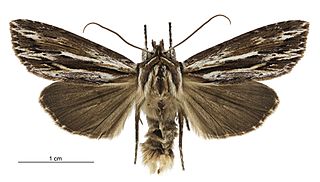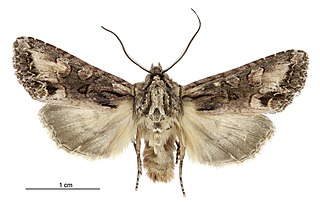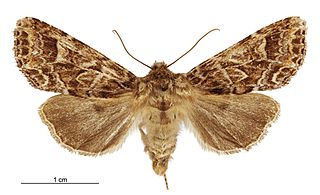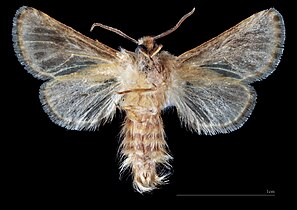
The shallot is a cultivar group of the onion. Until 2010, the shallot was classified as a separate species, Allium ascalonicum. The taxon was synonymized with Allium cepa in 2010, as the difference was too small to justify a separate species.

The bordered white or pine looper, is a moth of the family Geometridae. Among these, it belongs to tribe Bupalini of the subfamily Ennominae. B. piniaria is a common species throughout the western Palearctic region, the Near East and North Africa. However, its presence in certain regions – e.g. the northern Balkans – is doubtful.

The pine processionary is a moth of the subfamily Thaumetopoeinae in the family Notodontidae, known for the irritating hairs of its caterpillars, their processions, and the economic damage they cause in coniferous forests. The species was first described scientifically by Michael Denis and Ignaz Schiffermüller in 1775, though it was known to the ancients, with remedies described by Theophrastus, Dioscorides and Pliny the Elder. Its processionary behaviour was described in 1916 by the French entomologist Jean-Henri Fabre. It is one of the most destructive species to pines and cedars in Central Asia, North Africa and southern Europe.

Ceratomia amyntor, the elm sphinx or four-horned sphinx, is a North American moth in the family Sphingidae. The species was first described by Carl Geyer in 1835. It has a wingspan of 3+1⁄4-4+1⁄2 inches. As the name suggests, the larvae (caterpillars) feed on elm trees (Ulmus), but they can also be found feeding on birch (Betula), basswood (Tilia), and cherry (Prunus). When the caterpillars are ready, they crawl to the bottom of the host tree, where they crawl underneath the soil and pupate and may overwinter underground if late enough into the year. Vegetable growers should be aware of this larvae due to its insatiable appetite. One of these larvae are capable in devouring huge amounts of plant's foliage and even succulent stems.

The leek moth or onion leaf miner is a species of moth of family Acrolepiidae and the genus Acrolepiopsis. The species is native to Europe and Siberia, but is also found in North America, where it is an invasive species. While it was initially recorded in Hawaii, this was actually a misidentification of Acrolepiopsis sapporensis.

The black arches or nun moth is a small Palaearctic moth. It is considered a forest pest.

Pennisetia hylaeiformis, the raspberry clearwing, is a moth of the family Sesiidae.

Euxoa adumbrata, the sordid dart, is a moth of the family Noctuidae. The species was first described by Eduard Friedrich Eversmann in 1842. In North America it is found across northern Canada from Quebec to western Alaska, south to the northern parts of the United States, and in the mountains to Colorado. It is also found in Greenland, the coastal areas of Scandinavia and the Ural. It was recently recorded from Denmark, although this includes Euxoa lidia, which some authors regard to be a valid species.

Zygaena purpuralis, the transparent burnet, is a moth of the family Zygaenidae.

The Museum Witt Munich (MWM) is a department of the Bavarian State Collection of Zoology. It is located in Munich, Germany, and has the world's leading collection of moths.

Sabatinca aemula is a species of moth belonging to the family Micropterigidae. It is endemic to New Zealand and is found in the north western parts of the South Island. The larvae of this species has yet to be collected but it has been hypothesised that the larvae subsist on foliose liverworts similar to other species in the Sabatinca genus. The adults of the species are on the wing from the middle of September until the end of December. The adults of S. aemula are very similar in appearance to S. chrysargyra and it has been argued they can only be distinguished by dissection. However more recent research suggests that the colour patterns on the forewings of the two species can be sufficient to distinguish between the two species.

Setina flavicans is a moth of the family Erebidae. It is found in France and on the Iberian Peninsula.

Heliothela wulfeniana is a species of moth in the family Crambidae first described by Giovanni Antonio Scopoli in 1763.

Zygaena cynarae is a species of moth in the Zygaenidae family. It is found from France east to Russia.

Zygaena erythrus, common name sluggish burnet, is a species of moth in the family Zygaenidae.

Ichneutica similis is a moth of the family Noctuidae. It is endemic to New Zealand. This species is found only in certain parts of the North Island, in the western side of the South Island and on Stewart Island. It inhabits peatlands as well as inland and coastal wetlands. The life history of this species is unknown and the host species of its larvae has yet to be confirmed. It has been hypothesised that larval host species might be within the Empodisma genus as well as possibly the species Apodasmia similis.
Opharus corticea is a moth of the family Erebidae. It was described by Francis Walker in 1856. It is found in Venezuela.

Ichneutica chryserythra is a moth of the family Noctuidae. Living specimens have distinctive violet red coloured forewings but can be distinguished from the similar species Ichneutica marmorata as it lacks the dark edge markings of the later species. I. chryserythra can only be found in the southern parts of the South Island. Adults are on the wing between November and January. The life history of the species and the host species of its larvae are unknown.

Ichneutica bromias is a moth of the family Noctuidae. This species is endemic to the Chatham Islands of New Zealand where is found on the Chatham, Pitt and Rangatira Islands. This species is similar in appearance to Ichneutica mutans but is darker and duller in its overall appearance. However, as I. mutans is not present in the Chathams this similarity is unlikely to cause confusion. The adults of the species are on the wing from November to March. The life history and the larval host species are unknown.

Ichneutica brunneosa is a moth of the family Noctuidae. This species is endemic to New Zealand. It can be found in the North Island from Mount Te Aroha and in the South Island from the Coromandel to Stewart Island. However it appears to not be present in the centre of the South Island. The distinctive colour and patterns on the forewing of this species ensures it is unlikely to be confused with similar species. It inhabits native forests with higher rainfall and is attracted to mercury vapour light traps. The life history of I. brunneosa is unknown as are the host species of its larvae but the adults of the species are on the wing from October to January.





















